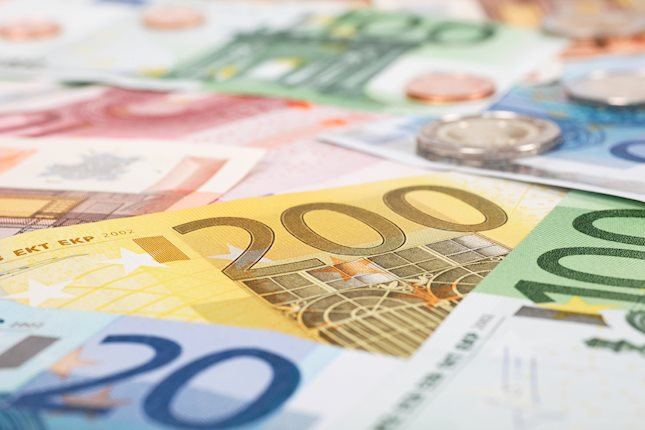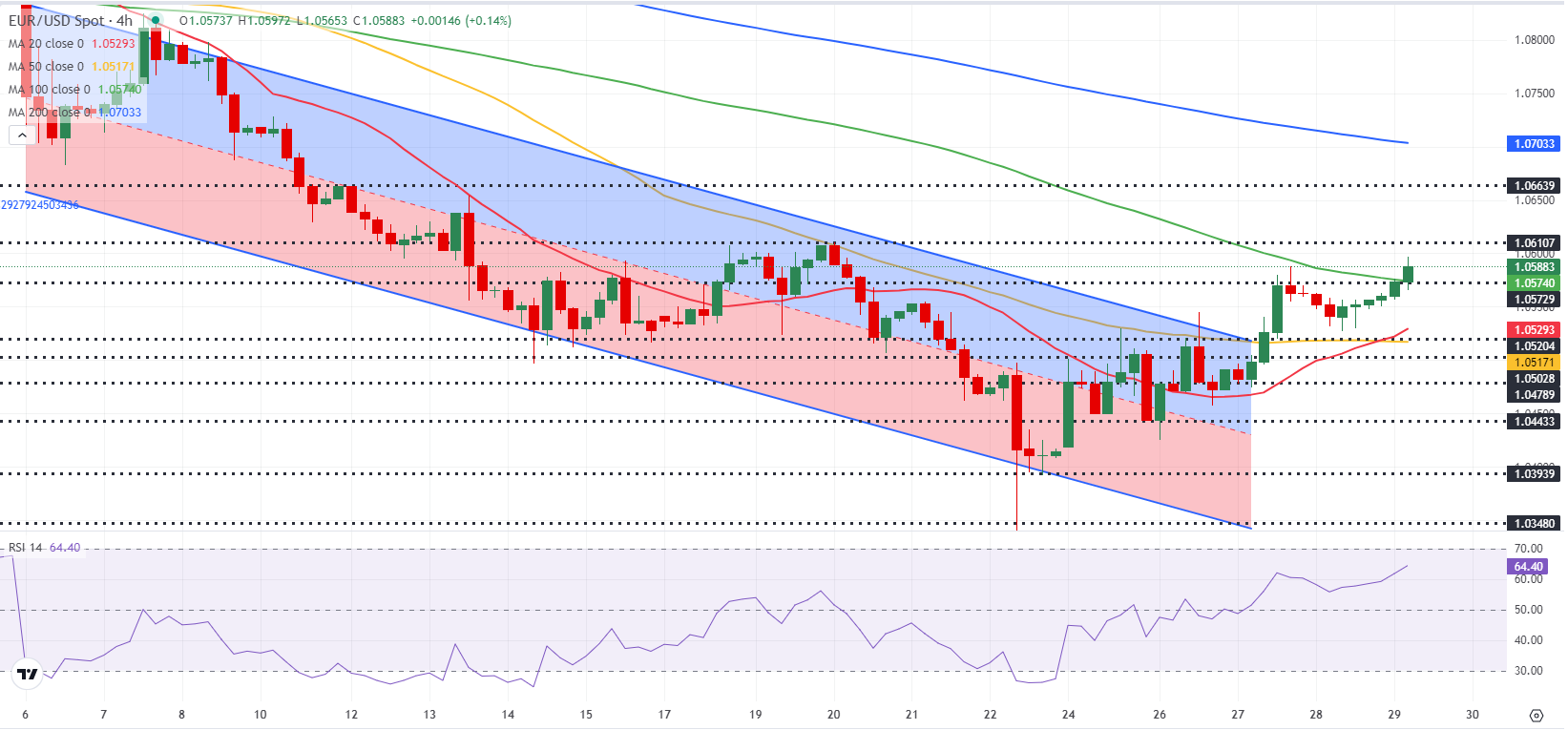- EUR/USD rises toward 1.0600 in the European morning on Friday.
- Eurostat will publish preliminary November inflation data for the Eurozone.
- The technical outlook points to a buildup of bullish momentum.
EUR/USD gains traction in the European morning on Friday and advances toward 1.0600. The pair's technical outlook highlights a buildup of bullish momentum as investors await November inflation data from the Eurozone.
Euro PRICE This week
The table below shows the percentage change of Euro (EUR) against listed major currencies this week. Euro was the strongest against the US Dollar.
| USD | EUR | GBP | JPY | CAD | AUD | NZD | CHF | |
|---|---|---|---|---|---|---|---|---|
| USD | -1.59% | -1.62% | -2.84% | 0.26% | -0.34% | -1.18% | -1.33% | |
| EUR | 1.59% | -0.20% | -1.90% | 1.28% | 1.20% | -0.16% | -0.32% | |
| GBP | 1.62% | 0.20% | -1.70% | 1.49% | 1.40% | 0.04% | -0.12% | |
| JPY | 2.84% | 1.90% | 1.70% | 3.22% | 3.04% | 1.79% | 1.77% | |
| CAD | -0.26% | -1.28% | -1.49% | -3.22% | -0.45% | -1.42% | -1.61% | |
| AUD | 0.34% | -1.20% | -1.40% | -3.04% | 0.45% | -1.34% | -1.49% | |
| NZD | 1.18% | 0.16% | -0.04% | -1.79% | 1.42% | 1.34% | -0.15% | |
| CHF | 1.33% | 0.32% | 0.12% | -1.77% | 1.61% | 1.49% | 0.15% |
The heat map shows percentage changes of major currencies against each other. The base currency is picked from the left column, while the quote currency is picked from the top row. For example, if you pick the Euro from the left column and move along the horizontal line to the US Dollar, the percentage change displayed in the box will represent EUR (base)/USD (quote).
The action in financial markets remained subdued on Thursday, making it difficult for EUR/USD to stage a decisive move in either direction, as trading conditions thinned out with financial markets in the US remaining closed in observance of the Thanksgiving Day holiday.
Early Friday, US stock index futures push higher and the benchmark 10-year US Treasury bond yields declines toward 4.2%, weighing on the US Dollar (USD) and helping EUR/USD stretch higher.
Eurostat will release preliminary Harmonized Index of Consumer Prices (HICP) data for November later in the session. On a yearly basis, the HICP is forecast to rise 2.3% following the 2% increase recorded in October. A stronger-than-forecast increase in this data could support the Euro with the immediate reaction.
Bond and stock markets in the US will close early on Friday and the US economic calendar will not feature any high-impact macroeconomic data releases. Hence, EUR/USD could face heightened volatility amid month-end flows toward the end of the European session.
EUR/USD Technical Analysis
EUR/USD climbed above the 100-period Simple Moving Average (SMA), currently located at 1.0575. Additionally, the Relative Strength Index (RSI) indicator on the 4-hour chart rose above 60, suggesting that the pair has more room on the upside before turning technically overbought.
On the upside, 1.0610 (static level) aligns as next resistance before 1.0660 (static level) and 1.0700 (200-period SMA). Looking south, first support could be spotted at 1.0575 (100-period SMA) ahead of 1.0520 (50-period SMA) and 1.0500 (round level, static level).
Euro FAQs
The Euro is the currency for the 19 European Union countries that belong to the Eurozone. It is the second most heavily traded currency in the world behind the US Dollar. In 2022, it accounted for 31% of all foreign exchange transactions, with an average daily turnover of over $2.2 trillion a day. EUR/USD is the most heavily traded currency pair in the world, accounting for an estimated 30% off all transactions, followed by EUR/JPY (4%), EUR/GBP (3%) and EUR/AUD (2%).
The European Central Bank (ECB) in Frankfurt, Germany, is the reserve bank for the Eurozone. The ECB sets interest rates and manages monetary policy. The ECB’s primary mandate is to maintain price stability, which means either controlling inflation or stimulating growth. Its primary tool is the raising or lowering of interest rates. Relatively high interest rates – or the expectation of higher rates – will usually benefit the Euro and vice versa. The ECB Governing Council makes monetary policy decisions at meetings held eight times a year. Decisions are made by heads of the Eurozone national banks and six permanent members, including the President of the ECB, Christine Lagarde.
Eurozone inflation data, measured by the Harmonized Index of Consumer Prices (HICP), is an important econometric for the Euro. If inflation rises more than expected, especially if above the ECB’s 2% target, it obliges the ECB to raise interest rates to bring it back under control. Relatively high interest rates compared to its counterparts will usually benefit the Euro, as it makes the region more attractive as a place for global investors to park their money.
Data releases gauge the health of the economy and can impact on the Euro. Indicators such as GDP, Manufacturing and Services PMIs, employment, and consumer sentiment surveys can all influence the direction of the single currency. A strong economy is good for the Euro. Not only does it attract more foreign investment but it may encourage the ECB to put up interest rates, which will directly strengthen the Euro. Otherwise, if economic data is weak, the Euro is likely to fall. Economic data for the four largest economies in the euro area (Germany, France, Italy and Spain) are especially significant, as they account for 75% of the Eurozone’s economy.
Another significant data release for the Euro is the Trade Balance. This indicator measures the difference between what a country earns from its exports and what it spends on imports over a given period. If a country produces highly sought after exports then its currency will gain in value purely from the extra demand created from foreign buyers seeking to purchase these goods. Therefore, a positive net Trade Balance strengthens a currency and vice versa for a negative balance.
Information on these pages contains forward-looking statements that involve risks and uncertainties. Markets and instruments profiled on this page are for informational purposes only and should not in any way come across as a recommendation to buy or sell in these assets. You should do your own thorough research before making any investment decisions. FXStreet does not in any way guarantee that this information is free from mistakes, errors, or material misstatements. It also does not guarantee that this information is of a timely nature. Investing in Open Markets involves a great deal of risk, including the loss of all or a portion of your investment, as well as emotional distress. All risks, losses and costs associated with investing, including total loss of principal, are your responsibility. The views and opinions expressed in this article are those of the authors and do not necessarily reflect the official policy or position of FXStreet nor its advertisers. The author will not be held responsible for information that is found at the end of links posted on this page.
If not otherwise explicitly mentioned in the body of the article, at the time of writing, the author has no position in any stock mentioned in this article and no business relationship with any company mentioned. The author has not received compensation for writing this article, other than from FXStreet.
FXStreet and the author do not provide personalized recommendations. The author makes no representations as to the accuracy, completeness, or suitability of this information. FXStreet and the author will not be liable for any errors, omissions or any losses, injuries or damages arising from this information and its display or use. Errors and omissions excepted.
The author and FXStreet are not registered investment advisors and nothing in this article is intended to be investment advice.
Recommended Content
Editors’ Picks

EUR/USD stays bid above 1.0550 ahead of Eurozone inflation data
EUR/USD is holding gains above 1.0550 in the European trading hours on Friday. The pair derives strength from the peristent US Dollar weakness, further fuelled by the USD/JPY sell-off. Buyers, however, remain cautious ahead of the Eurozone preliminary inflation data.

GBP/USD regains 1.2700 on weaker US Dollar
GBP/USD retains some follow-through positive traction above 1.2700 in European trading on Friday, sitting close to a two-week top. Broad-based US Dollar weakness, improving risk appetite and thin market condtions continue to aid the pair's recovery.

Gold price eases off weekly highs, remains above $2,650
Gold price has eased from the weely highs but holds moderate gains above $2,650 in the European session on Friday. Gold price builds on this week's goodish rebound from the $2,600 neighborhood. US President-elect Trump's tariff plans, Russia-Ukraine geopolitical risks and dovish Fed bets power the bright metal.

Bitcoin attempts for the $100K mark
Bitcoin (BTC) price extends its recovery and nears the $100K mark on Friday after facing a healthy correction this week. Ethereum (ETH) and Ripple (XRP) closed above their key resistance levels, indicating a rally in the upcoming days.

Eurozone PMI sounds the alarm about growth once more
The composite PMI dropped from 50 to 48.1, once more stressing growth concerns for the eurozone. Hard data has actually come in better than expected recently – so ahead of the December meeting, the ECB has to figure out whether this is the PMI crying wolf or whether it should take this signal seriously. We think it’s the latter.

Best Forex Brokers with Low Spreads
VERIFIED Low spreads are crucial for reducing trading costs. Explore top Forex brokers offering competitive spreads and high leverage. Compare options for EUR/USD, GBP/USD, USD/JPY, and Gold.
